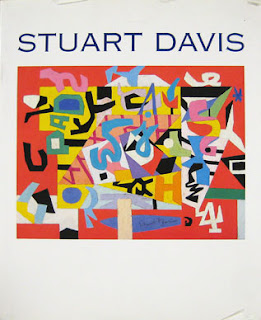These two artists changed my thinking about the purpose of art. The artist statement by Jose Clemente Orozco (Mexican 1883-1949) concerning his mural “The Epic of American Civilization” (1932-1934) further cemented my new perceptions. He said (his capitals) “IN every painting, as in any other work of art, there is always an IDEA, never a STORY. The idea is the point of departure, the first cause of the plastic construction, and it is present all the time as energy creating matter. The stories and other literary associations exist only in the mind of the spectator, the painting acting as the stimulus.”
The value of the art lies therefore within the viewer. For example viewing paintings by Stuart Davis (American, 1894-1964) is an experience in lyricism. Davis explored how painting was like music through colors, shape, and words. Each painting reflects the pulse of a place, rather than the place itself. A forefather of the Pop Art Movement, Davis translated squiggly lines and flashing colors into striking visual images.
Another example music explored as painting is “Jazz” (1947) by Henri Matisse (French, 1869-1954). With his painted cutouts and bright colors, Matisse created the visual aspect of jazz. His designs experimented with rhythm and repetition that was broken by improvisation much like jazz music.
In contrast, the Neoclassism Movement (1760-1850) regarded art to be a medium to uplift and enlighten the spectator. Subjects from ancient Greece and Rome were plumbed for their ability to morally educate people. The purpose of art was therefore to promote ethical behavior for all classes. Hence, “The Stone Breakers” (Gustave Courbet, 1849) or “The Man with the Hoe – L’homme a la loue” (Jean-Francois Millet, 1860-1862) was scandalous. Menial labor was not a worthy topic for art.
What is considered art changes in various eras. Menial labor instead of abstract art can be a vehicle to contemplate life. From my experiences in studying art, I learnt that art for art’s sake encompasses a wide variety of art. It is up to the viewer to decide how to regard it. Art simply is. It has no other purpose than to simply be. In his principles of aesthetics, Immanuel Kant (German, 1724- 1804) stressed that the object of art should exist only for itself. Art becomes a vehicle for the observer to engage with it.
I now agree with Oscar Wilde (Irish, 1854-1900) on beauty and art. He said, “Aestheticism is a search after the signs of the beautiful. It is the science of the beautiful through which men seek the correlation of the arts. It is to speak more exactly the search after the secret of life.” Art for art’s sake prompts us to seek beauty. We contemplate the art and discover life. We can look at Pollock’s drip paintings or “The Stone Breakers” as a window on life beyond our senses.
Works Used
Arnold, Michael, “Stuart Davis, American Painter, 1894-1964” Simply Art, 2011, http://www.michaelarnoldart.com/Stuart%20Davis.htm,
Coyle, Laurie and Rick Tejada-Flores, “OROZCO: Man of Fire”, Paradigm Productions, 2007, http://www.paradigmproductions.org/films/orozco/?c=synopsis,
Dabrowski, Magdalena, “Henri Matisse (1869–1954)”, Heilbrunn Timeline of Art History, New York: The Metropolitan Museum of Art, October 2004, http://www.metmuseum.org/toah/hd/mati/hd_mati.htm,
Essak, Shelley, “All About Art History”, About.com, http://arthistory.about.com/,
---, “Guide to Art History”, ArtHistory.net, 2009, http://www.arthistory.net/,
Janson, H.W. and Dora Jane Janson, “The Story of Painting”, Harry N Abrams: New York, 1966.
Horsley, Carter, “Mumbo Jumbo and Mud Pies: Jackson Pollock”, The City Review, 1999, http://www.thecityreview.com/pollock.html,
---, “Matisse: Life and Painting”, Henri Matisse.net, 2011, http://www.henri-matisse.net/index.html,
---, “Orozco – An Epic of American Civilization”, Dartmouth College, http://www.dartmouth.edu/~library/Orozco/epic.html,
Slater, Barry, “Aesthetics”, Internet Encyclopedia of Philosophy, July 2005, http://www.iep.utm.edu/aestheti/,
---, “Willem de Kooning”, The Art Story: Modern Art Movement, 2011, http://www.theartstory.org/artist-de-kooning-willem.htm,

No comments:
Post a Comment